
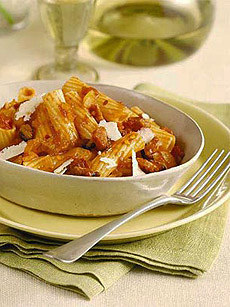 Rigatoni all’Amatriciana. Photo courtesy of BarillaUS.com (the recipe is on the website).
Rigatoni all’Amatriciana. Photo courtesy of BarillaUS.com (the recipe is on the website).
Last Updated May 2024
|
 |
Pasta Glossary
Page 7: Pasta Types With R
If you enjoy this Pasta Glossary, we have a food glossary for almost every category of food, including Italian favorites like cheese, espresso and olive oil. Plus, find reviews of our favorite brands of pasta and sauces, pasta recipes and informative articles about pasta in our Pasta Section.
Click on a letter of the alphabet to get to
the appropriate page of the glossary.
a b c d e f g h i j k l m n o p q r s t u v w x y z
This glossary is protected by copyright and cannot be reproduced in whole or part.
|
RADIATORE
The Italian word for “radiators,” radiatore (rah-dee-a-TOE-ray) are short, chunky pasta shapes about 1 inch by 1/2 inch, with ruffled ridges that radiate out. One of the more elegant pasta shapes, they look great sauced or in casseroles, salads, and soups.
RAGÙ
A ragù (rah-GOO) is a meat-based sauce. The Italian word derives from the French ragoût, from the verb ragoûter, “to revive the taste.” A ragù is usually made by adding meat to a soffrito, a mixture of chopped onions, celery, carrots, and seasonings (garlic and fresh herbs such as parsley or sage), that is partially fried in olive oil. (A sofritto is the progenitor of the French concept of the mirepoix.) It is then simmered for a long time with tomato sauce.
Ragù can be made with any meat or game. Ragù alla bolognese (sometimes known as Bolognese sauce) is made with ground pork, beef, and pancetta. Ragù alla Napoletana (Neapolitan ragù) includes sliced beef, raisins, and pine nuts.
|
|
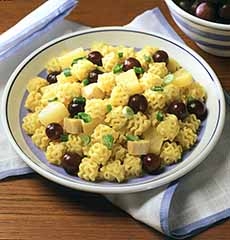
Radiatore with olives and pistachios. (photo © National Pasta Association).
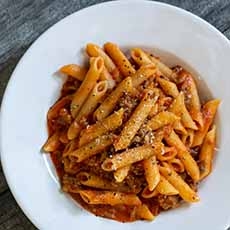
Penne rigate with a ragù. (photo © National Pasta Association).
|
RAMEN
Ramen are Japanese wheat noodles. While they are known to Americans largely as salty, inexpensive packaged noodle soup mixes, in Japan there are as many varieties of noodles and recipes as there are prefectures, ramen dishes are fine cuisine and innovation is the name of the game, where recipes are closely-guarded secrets.
RAVIOLI
Pasta pillows stuffed with a variety of cheese, meat, seafood, or vegetable fillings. Ravioli (rah-vee-OH-lee) can be circular or square; specialty shapes like hearts and fish are also made. They are served with butter or olive oil, sauce, or in soups. Here’s the history of ravioli. Read reviews of some of our favorite ravioli.
RAVIOLI LASAGNA
A lasagna made by layering ravioli instead of lasagna noodles, complete with all the traditional lasagna ingredients. Here are photos and recipes.
RAVIOLINI
Miniature raviolini. These can be served as a pasta dish, hors d’oeuvres, or put into soup, like won tons.
|
|
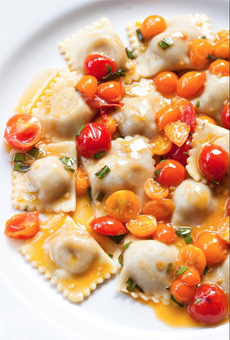
Ravioli with cherry tomato sauce. Photo courtesy Delfina restaurant. |
RAVIOLONI
Large ravioli (rah-vee-oh-LOE-nee). They can be as large as three-inch circles and four-inch squares or rectangles (you can see that the piece at the right is almost as long as the fork). One piece suffices as a first course, or two pieces as a main dish. The best ones have interesting fillings, beyond the normal vague meat, cheese, and vegetables. The ravioloni here, from Nuovo Pasta (a NIBBLE Top Pick Of The Week) is filled with spicy sausage, escarole, and roasted garlic.
|
|
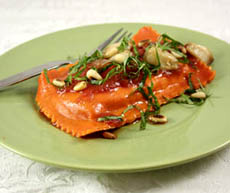
Photo by Ryan Clark. Read the full review of Nuovo Pasta. |
RIBBON PASTA
As opposed to round pasta like spaghetti, ribbon pastas are flat strands. They are made in varying lengths, widths, and thicknesses, from delicate linguine to mid-width fettuccine and tagliatelle to the wide pappardelle to the widest, the two-inch-wide lasagne. Ribbon pasta can have straight or wavy edges. It can be purchased fresh and dried.
|
|
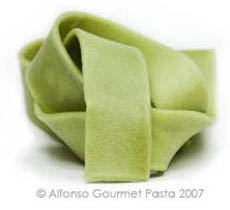
Spinach pappardelle from AlfonsoGourmetPasta.com. |
RICE STICKS
Thai noodle dishes, such as the famous Pad Thai, are made from rice sticks. These are vermicelli-shaped thin strands that are made from rice flour and water, instead of wheat flour. Because the noodles are stir-fried, not boiled, they must be soaked in warm water for an hour prior to cooking. They are also available in a wider form for other dishes.
RICCIA LARGA
Medium-width lasagne noodles with frilled edges. Pronounced REE-cha LAHR-ga.
RIGATONCINI
A somewhat skinnier, smaller version of rigatoni (ree-gah-tone-CHEE-nee). The size and density of these ridged tubes are best suited to thick, clingy sauces. This cut also works well with al forno-style preparations. Artisanal rigatoncini by Rustichella d’Abruzzo are available from SalumeriaItaliana.com.
RIGATONI
The most commonly used cut in southern and central Italy, rigatoni (rih-gah-TOE-nee) are large, ridged, slightly curved tubes of pasta with square-cut ends. The name comes from the Italian “rigato,” the past participle of “rigare,” to draw a line. They are excellent for chunky meat sauces and cheese sauces because the ridges, or grooves, catch the sauce. The large diameter of the rigatoni tube, as well as the penne and mostaccioli tubes, make them ideal for catching pieces of meat or vegetables in the sauce—the entire surface, both inside and out, works to adhere to the sauce.
|
|
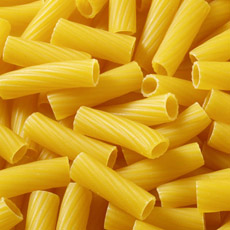
Rigatoni. Photo courtesy BarillaUS.com. |
The difference between rigatoni and penne is that penne have angle-cut ends. See the photo of Rigatoni all’ Amatriciana at the top of this page. A famous preparation, it includes a sauce of plum tomatoes, crushed red pepper flakes, pancetta or bacon, and grated Romano cheese.
ROTELLE
Also known as rotelle, rotelle is part of a group of pasta shapes that includes radiatori and lancette. The name means “wheels” in Italian. Inspired by the world of automobile mechanics which emerged in the early 1900s. See ruote, below.
ROTINI
Originating in northern Italy, rotini are “spirals” or “twists” shorter than fusilli, about 1-½ inches long, with a tighter spiral that helps retain the local pesto sauce better. They are popularly used in pasta salads as well.
|
|
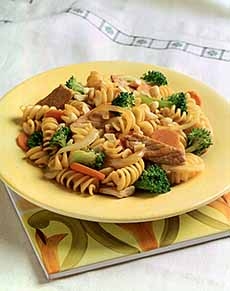
Rotini with broccoli and pork (photo © I Love Pasta). |
RUOTE or WAGON WHEELS
Smaller and tighter-spoked than rotelle, route are wheel-shaped pasta. Ruote (RUO-tay with an uo diphthong) means wheels in Italian. Like rotelle, ruote are paired with heavy meat or cheese sauces, which get “trapped” in the spokes.
|
|
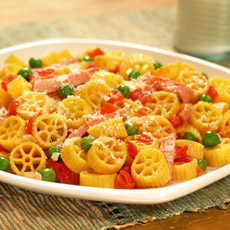
Ruote, or wagon wheels. Photo courtesy of BarillaUS.com. |
Go To The Next Page, Words Beginning With S
Go To The Glossary Alphabet Index, Above
© 2005-

|












